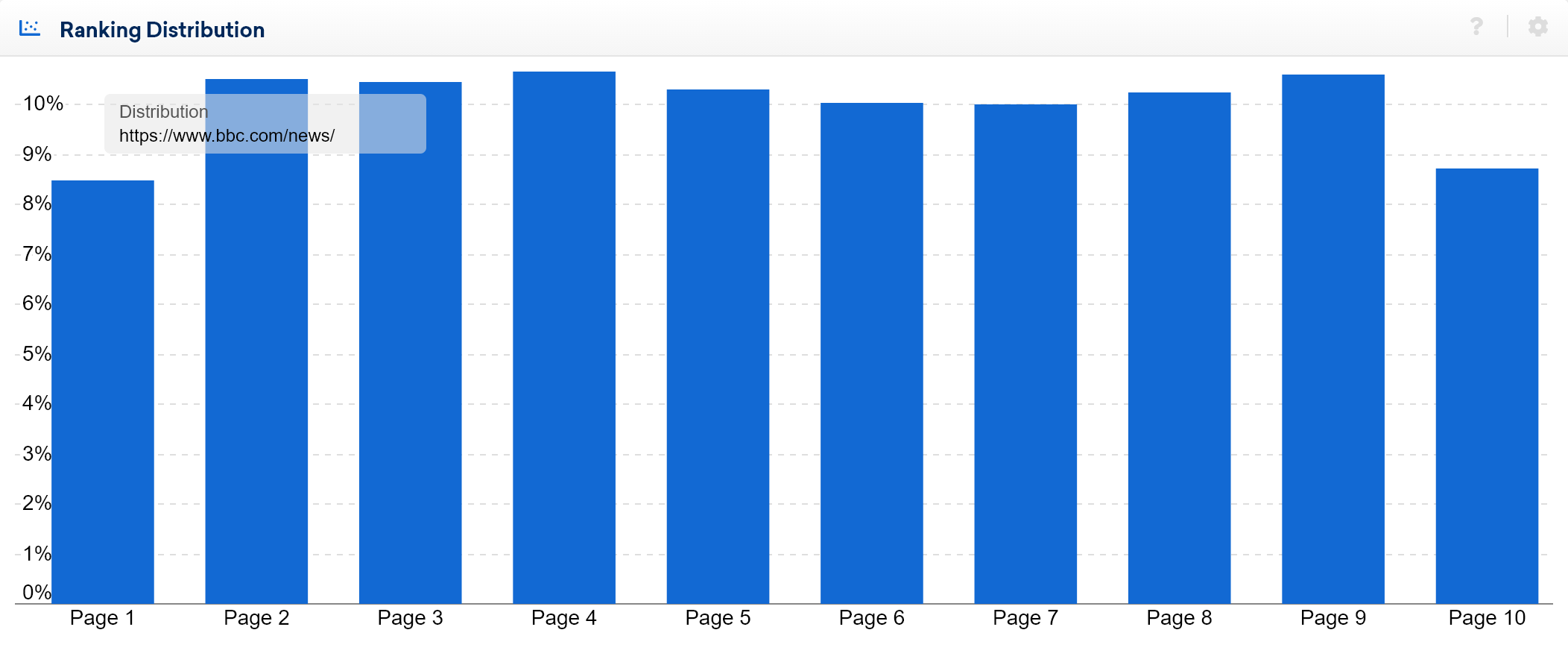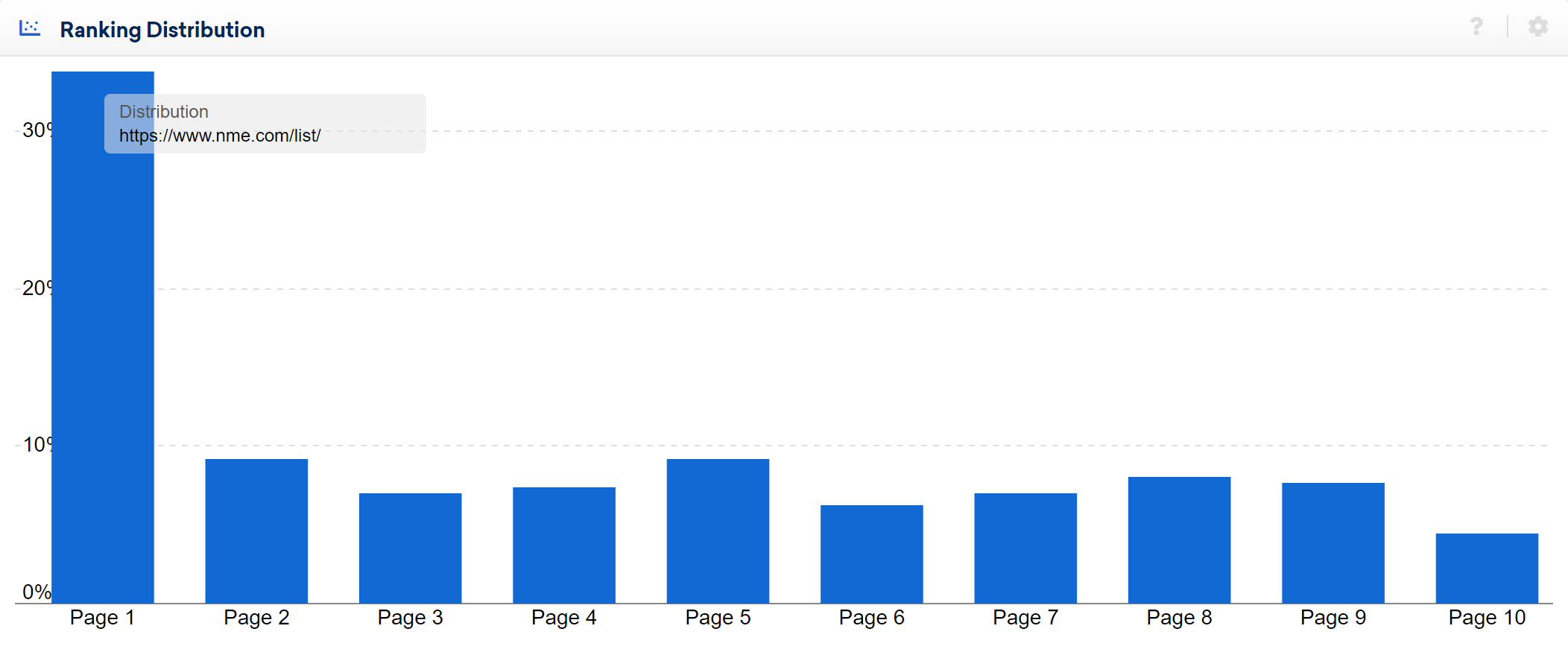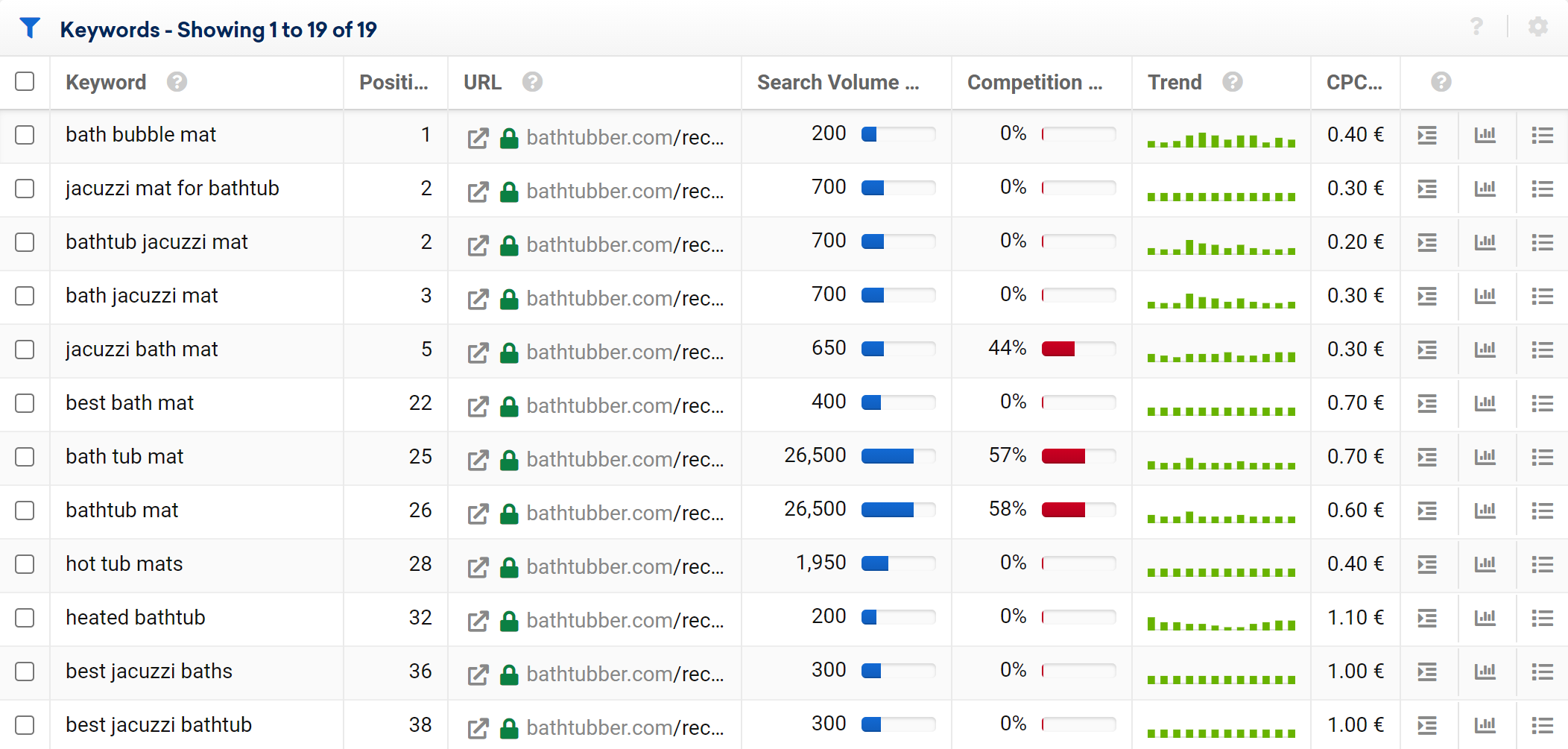Hardly any other performance figure reveals as much about the state of a website’s search engine optimisation as its ranking distribution. This article reveals what you can take from it and what needs to be considered.
- What is the ranking distribution?
- Why is the ranking distribution so important?
- What forms of ranking distribution are there?
- High-performance (falling from left to right)
- Average distribution (equally distributed)
- Low performance (increasing from left to right)
- The truth is not always directly on the surface
- Example: the entire nme.com domain (average distribution)
- Example: the nme.com/list/ directory (high-performance distribution)
- Example: the nme.com/artists directory name (low-performance distribution)
- Factors influencing ranking performance
- Google: Hit Rate Relevance
- Google: Hit rate importance
- Users: hit rate satisfaction
- Ranking distribution and user signals
- How do I improve my ranking distribution?
What is the ranking distribution?
The ranking distribution shows how a website ranks across Google search results pages for a variety of different keywords. This distribution illustrates the percentage of keywords for which a website appears on the first search results page (positions 1 to 10), the second search results page (positions 11 to 20), etc. all the way up to the tenth search results page (positions 91 to 100).
Why is the ranking distribution so important?
How often an archer hits his target depends on two factors: how many arrows he has and his hit rate. If he has 100 arrows and a hit rate of just 2%, only two arrows will hit the target.
Speaking in SEO terms, the number of arrows refers to the number of keywords, and the hit rate is the proportion of rankings on the first search results page (positions 1 to 10). This is because around 99% of all clicks on organic search hits are on pages that appear in positions 1 to 10. You therefore only have a significant chance of being seen and clicked on in Google results if you rank for keywords on the first search results page. In the ranking distribution, we are therefore particularly interested in the percentage of top 10 rankings.
This SEO hit rate can be referred to as ranking effectiveness or ranking performance. It largely determines SEO success: whether the ranking performance is 5 percent or 50 percent makes a huge difference.
What forms of ranking distribution are there?
One can distinguish between three ideal-typical forms or patterns of ranking distribution.
High-performance (falling from left to right)
Ideally, the height of the bars in the ranking distribution falls from left to right. This pattern makes SEO professionals happy. Most keywords are ranked among the first ten hits, i.e. appear on the first search results page.

Values of 20% or more count as high-performance content. If the website offers relevant content for a keyword, the chances are above average that Google will display the content as a hit on its first search results page.
Average distribution (equally distributed)
The average distribution refers to instances in which all the bars are roughly the same height, i.e. each of their values are close to 10%.

An average distribution is often an indication that Google simply does not understand large parts of a website’s content and then displays its pages in search results for irrelevant keywords. Of course, an SEO will not and cannot be satisfied by this. The aim for SEO professionals is to achieve an above-average ranking performance.
Low performance (increasing from left to right)
If the height of the bars increases from left to right, we call this a low-performance distribution. The proportion of top 10 rankings is below 10% and thus below the general average. This indicates that a website suffers from substantial SEO problems. Such a distribution can be observed when a site has been hit with a Google penalty or received poor user signals.

In the example shown, users can only read the website’s content from the second visit onwards after having registered with the site. This is likely to lead to lots of short clicks and a corresponding drop in rankings.
New domains are a special case. They often have a low-performance profile in their ranking distribution. However, this is not necessarily an SEO problem. These websites must first earn Google’s trust over time.
The truth is not always directly on the surface
Many websites consist of a number of different sections, formats and page types, e.g. shop, blog, forum, etc. These formats usually also perform very differently. The ranking performance of the website as a whole is therefore often only an average and does not adequately reflect the strengths and weaknesses of the website. For a meaningful analysis, therefore, it is essential to also look at the ranking performance of the individual directories and host names, including individual URLs if necessary. The following three charts show all three ideal-typical ranking distributions on the domain bremen.de if one digs a little deeper and looks at different sections of the website.
Example: the entire nme.com domain (average distribution)

Example: the nme.com/list/ directory (high-performance distribution)

Example: the nme.com/artists directory name (low-performance distribution)


Factors influencing ranking performance
Ranking performance depends on the following three factors:
Google: Hit Rate Relevance
All of the ranking data shows that Google needs very clear signals as to the keywords for which a URL is relevant in order to display it in the results for relevant searches. This detection is much more difficult for Google than one might expect, as websites often send the wrong signals.
While this seem an extreme example, due to the words used, the example shows how Google may struggle to understand the true target of the content. Example: If a page offering “best jacuzzi bath mat” (a powered accessory for inside a standard bath) information links to “jacuzzi installtion” and other bathtub information, Google also considers this document when assessing its rankings for keywords such as “best bath mat” and “best jacuzzi baths”.

These rankings are completely inappropriate because the website does not offer bathtubs at all. The signals were simply not clear enough for Google to make a clear determination of relevance. One can imagine that generic words in link texts, such as “more” and “products”, lead to an unsightly ranking distribution, as would, for example, using the title “Between the Oceans” for an article about Nicaragua as a travel destination. Such “interfering signals” are far from an exception on the web and present a problem not just for Google but also with regard to user orientation.
Increasing Google’s hit rate through clear relevant signals therefore has a significant impact on ranking performance.
Google: Hit rate importance
The importance of a page in Google’s eyes is determined to a significant degree by linking. Internal links play a major role, as most URLs on the web are only linked internally and not externally from other domains. A well-thought-out strategy for internal linking is therefore a prerequisite for good ranking performance, as otherwise Google can hardly tell which pages are important and which are not.
Users: hit rate satisfaction
If Google has correctly identified the relevance, the hit pages must also satisfy the users. If the hits do not satisfy the users’ search intentions, they will acknowledge this with negative user signals, such as an above-average number of short clicks. In the long run, this has a negative effect on ranking performance. For a good ranking performance, as much content as possible must satisfy the user’s search intention.
Ranking distribution and user signals
Let’s take a closer look at that final point: “user satisfaction”. One reads more and more often articles such as “The classic ranking factors no longer exist” or “Every keyword has its own ranking factors”. I would only agree with these statements to a limited extent. Undeniably, user signals have gained great importance in recent years and have changed the SEO world greatly. Even if the various user signals have much in common, they are definitely different for each keyword. In this regard, ranking successes can no longer be explained so simply.
However, this does not mean that the classic ranking factors no longer apply. The overall package is what matters most. You have to fulfil the classic ranking factors and also generate positive user signals. A URL that is not indexed in the first place, or a page in which Google does not recognise the relevance for a keyword, will not get the chance to score in the top 10 at all via good user signals. Conversely, the best optimisation of the classic SEO factors is of no use if the content does not correspond to the search intention of the users.
Points such as “search intention”, “user satisfaction” and “search experience” are unfortunately very soft factors that cannot be easily measured with hard key figures. At this point, the ranking distribution, which is important anyway, once again assumes a very special significance.
The ranking distribution gives clear indications as to which content is well received by users, and a good ranking performance is only possible with positive user signals. The ranking distribution thereby clearly shows us where to find them. We then only have to interpret what users like about this successful content. Because the ranking distribution in most cases looks at a large number of keywords and URLs, the analysis is much less susceptible to coincidences and spurious signals. It thus provides clear and practical insights, which I will show in my next blogposts.
How do I improve my ranking distribution?
In the next few articles, I will publish a whole series of blogposts with a focus on content marketing and lots of examples based on ranking performance. In doing so, I will go into detail about the influencing factors and optimisation options. I will continuously add the links to these blogposts as a list below this post.
